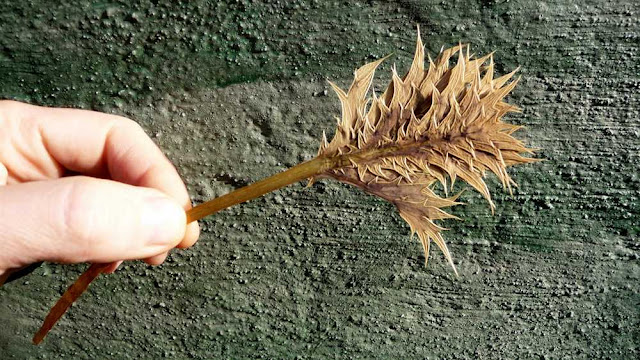What appears to be a Chinese dragon-like ideogram is only the shadow
of an Eryngium campestre leaf.
Eryngium campestre (also known as "field eryngo") is a perennial thistle of Europe and the Mediterranean region, that matures slowly, and gradually establishes itself in its habitat. When not in a year of blooming, one can easily observe the long-stalked, grey-green, basal leaves standing on the ground. You can't miss them when treading Greek soil, especially in low altitudes. I find these mysterious, rigid, origami-like, leaves really interesting. The spiny flowers, in the impressive round inflorescence, are green, and the dry plant is often carried away as a tumbleweed, in winter.
The roots of this medicinal plant are used in treating liver disorders.
__________________________________________________________________
Το Eryngium campestre είναι ένα πολυετές αγκάθι της Ευρώπης και της Μεσογείου, το οποίο ωριμάζει αργά και εγκαθίσταται σταδιακά σε μια περιοχή. Τις χρονιές που το φυτό δεν ανθοφορεί, εύκολα μπορεί κανείς να παρατηρήσει τα γκρι-πράσινα φύλλα που προεξέχουν από το έδαφος. Όποιος έχει περπατήσει στην ελληνική ύπαιθρο, ειδικά σε χαμηλό υψόμετρο, έχει συναντήσει αυτό το φυτό. Ιδιαίτερο ενδιαφέρον παρουσιάζουν αυτά τα μυστηριώδη, αναδιπλούμενα σαν origami, φύλλα. Τα αγκαθωτά λουλούδια στην διακλαδισμένη ημισφαιρική ταξιανθία, είναι πράσινα, και ολόκληρο το ξερό φυτό συχνά παρασύρεται απ΄ τον άνεμο μες στον χειμώνα.
Οι ρίζες του Eryngium campestre χρησιμοποιούνται για την αντιμετώπιση παθήσεων του ήπατος.
Anybody who has walked on Greek soil has come across this uncanny picture.
A flat, press-dried, Eryngium campestre unfolding leaf.
The miniature leaves of an immature plant.
The almost uprooted rhizome of an Eryngium campestre plant.




































Very beautiful
ReplyDelete